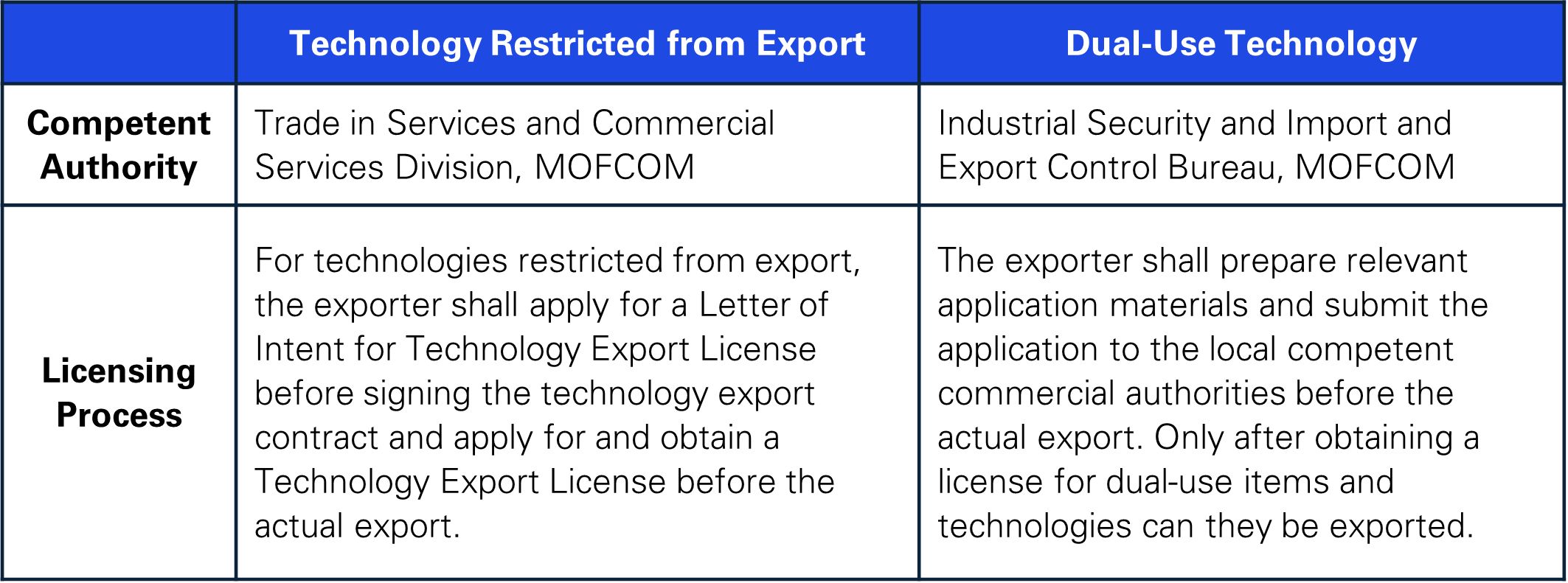Summary
On December 30th 2022, the Ministry of Commerce, together with the Ministry of Science and Technology and other authorities issued the Notice on Soliciting Public Comments on the Revision of “the List of Technologies Prohibited and Restricted from Export of PRC”, with a view to revising the List. In this revision, 32 technology items are to be deleted, 36 are to be modified, and 7 are to be added. After the revision, there will be a total of 139 items in the List, including 24 technology items prohibited and 115 technology items restricted from export.
Background
According to the provisions of the Foreign Trade Law of PRC and the Administrative Regulations of PRC on Import and Export of Technologies, the Ministry of Commerce (MOFCOM), together with the Ministry of Science and Technology and other relevant authorities of China, shall conduct classified administration on the import and export of technologies. According to the management mode of the import and export of different categories of technologies, the import and export of technologies are classified into three categories, namely, the technologies free to import and export, the technologies restricted from import and export and the technologies prohibited from import and export.
The List of Technologies Prohibited and Restricted from Export of PRC (Draft for Comments) (or List (Draft for Comments)) stipulates the scope of administration of technologies prohibited and restricted from export. The List was initially published in 2001 with subsequent revisions made in 2008 and 2020.
Due to its special nature, technology import and export will not only impact related commercial fields, but also involve national security and other public issues. The revision of the List (Draft for Comments) by Chinese authority not only reflects China's strengthening of technology trade cooperation with other countries and continuous optimization of the business environment for technology trade, but also reflects China’s national security concerns in the export control of emerging technologies and other aspects under the guidance of the overall national security concept.
Key revisions to the List (Draft for Comment)
According to the information released by the MOFCOM, this revision intends to delete 32 items, modify 36 items and add 7 items. The revised List has a total of 139 items, including 24 technologies prohibited from export and 115 technologies restricted from export.1 In this revision, the List has been significantly reduced and some control points of technology items have been furnished with more details, creating favourable environment for strengthening international technical cooperation.
Generally, the deleted items in this revision are mostly concentrated in traditional industries, such as agriculture, food industry, textile industry, chemical industry, machinery and equipment manufacturing industry, and do not involve cutting-edge emerging technologies. Most of the added items involve key or emerging technology industries such as biotechnology, rare earth resources, photovoltaic and intelligent vehicles, which echoes the concerns of Chinese authority in protecting national security and public interests.
KPMG observations
The last time the Chinese government revised the List of Technologies Prohibited from Export and Restricted from Export was in August 2020, and at that time the MOFCOM said it would continue to revise the list in due course. The revisions in the List (Draft for Comment) issued on December 30th 2022 can be seen as a continuation of the previous revision, strengthening technology export control for key emerging technologies of strategic significance. Against the global backdrop of strategic competition between China and the United States, and against the backdrop of China's growing high-tech industry, It has strengthened the protection of China's own national security and development interests. In parallel, the Chinese government has also moderately adjusted the export control of relevant technologies in traditional industries, in order to promote transnational technology trade and cooperation.
1. The Strengthen Technology Export Control of China
As noted above, this is the third revision made to the List. It can be seen that the Chinese government increases the frequency of revision to adapt to internal and external environmental changes. On the purpose of China’s technology export control, in the context of the big picture of international trade and the continuous improvement of China's independent scientific and technological innovation capability, as well as the rapid development of high-end technology industry, the Chinese authority will see national security concerns much more vital in technology export and international technology cooperation, and the technology export control will respectively be constantly strengthened and improved. The revision of the List will remain frequent in the near future, and will focus on items involving emerging key technologies.
In this regard, we suggest that enterprises in the emerging technology industry keep close eyes on the dynamics of government regulation, strengthen the construction of internal compliance and risk control system, timely review the technical items of the technical assets owned by enterprises, and make preparations for future regulatory changes.
2. "Restricted from Export" Technology and "Dual-Use" Technology
In China, the export control of technology includes the control of "prohibited and restricted from export" technologies in the Foreign Trade Law of the PRC and the control of dual-use items and technologies in the Export Control Law of the PRC. For enterprises involved in technology export, both controls should be paid attention to.
First of all, although the above two controls have different focuses, one single technology item can still be constrained by the above two controls at the same time. Therefore, enterprises need to assess whether the technology involved is restricted by the above two controls before conducting technology export.
Secondly, the above two controls are parts of China's existing export control regimes, but there are slight differences in implementation. Enterprises should pay attention to the impact of timing requirements of licensing on the transaction, so as to avoid any unauthorized export.

If you have any questions about the above, please feel free to contact the relevant tax experts at KPMG for further discussion.
1 For details, please refer to the Appendix.
Appendix

Connect with us
- Find office locations kpmg.findOfficeLocations
- kpmg.emailUs
- Social media @ KPMG kpmg.socialMedia


